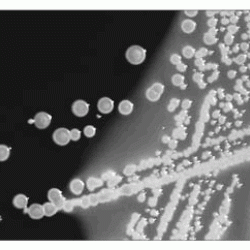Source Institutions
Source Institutions
Add to list Go to activity
Activity link broken? See if it's at the internet archive

In this four-day activity, learners grow bacteria and/or fungi from a variety of locations and compare the results. They will learn that microbes are everywhere; some such as bacteria and fungi grow readily on sources of food and water. This lesson guide includes background information, safety considerations, and extensions.
- 30 to 45 minutes
- 1 to 7 days
- $10 - $20 per group of students
- Ages 8 - 14
- Activity, Experiment/Lab Activity, Lesson/Lesson Plan
- English
Quick Guide
Materials List (per group of students)
- 750 mL of nutrient agar (purchase as powder or bottled agar gel)
- 33 100-mm sterile, disposable Petri dishes (to prepare 30 dishes with agar and 3 dishes for templates for student drawings)
- 36 small, resealable plastic bags
- Chlorine bleach solution
- Cotton swabs, 100 count box
- Disinfectant (liquid soap or spray)
- Hot pads or pot holders
- Paper towels
- Resealable plastic bag, medium-size
- Container of distilled or boiled water
- Magnifiers or low power microscopes
- Masking tape
- Permanent marker or wax pencil
- Colored pencils or markers
- 12 sheets of white paper for observations (3 per learner)
- Graph or plain paper
- Group concept map (ongoing, if available)
Subjects
-
Life Sciences
-
Cells
- Cell Structure and Function
-
Diversity of Life
- Viruses and Bacteria
- Protists and Fungi
- Classification
-
Ecology
- Ecosystems
- Populations
-
Human Body
- Health and Nutrition
- Medicine
- Immune System
-
Cells
-
Mathematics
-
Data Analysis and Probability
- Data Analysis
- Data Collection
-
Data Analysis and Probability
-
The Nature of Science
-
The Scientific Process
- Conducting Investigations
- Gathering Data
- Formulating Explanations
- Communicating Results
-
The Scientific Process
Informal Categories
- Food and Cooking
- Nature and Environment
Audience
To use this activity, learners need to:
- see
- see color
- read
- touch
Learning styles supported:
- Involves teamwork and communication skills
- Involves hands-on or lab activities
Other
Components that are part of this resource:
Includes alignment to state and/or national standards:
Includes assesments for student learning:
- What Do You Know About Microbes? (pre-assessment)
- And Now, What Do You Know About Microbes? (post-assessment)
This resource is part of:
Access Rights:
- Free access
By:
- Moreno, Nancy P. ; Tharp, Barbara Z. ; Erdmann, Deanne B. ; Clayton, Sonia Rahmati ; Denk, James P.
Rights:
- All rights reserved, Baylor College of Medicine, 2008
Funding Source:
- Science Education Partnership Award, 5R25 RR018605
